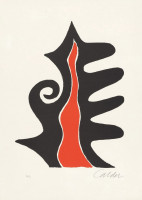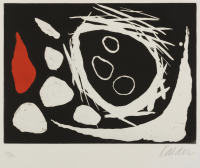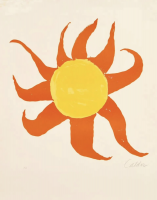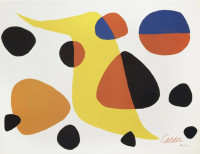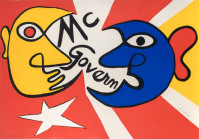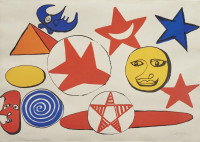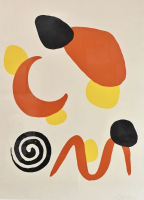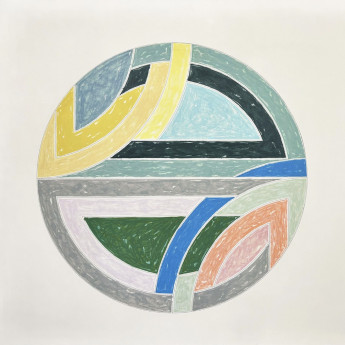
Details
Artist
Styles
Lithograph in colors on wove paper - Signed and numbered in pencil - Published by Maeght, Paris. // Alexander Calder's Papouse (1969) is a bold and energetic lithograph that showcases his mastery of form, color, and movement. The composition features a large red semicircle accented with dynamic blue and red vertical stripes, surrounded by thick, black and white geometric patterns and swirling shapes. The contrasting colors and strong lines give the piece a rhythmic quality, evoking a sense of motion that is both playful and structured. The high contrast of red, blue, and black on a predominantly white background intensifies the visual impact, drawing the viewer’s eye across the composition. Measuring 29 x 42.5 inches, this lithograph was published by Maeght in Paris and is signed and numbered in pencil by Calder in an edition of 75. Papouse embodies Calder’s ability to transform simple shapes into vibrant, kinetic art.
Papouse, 1969
form
Medium
Size
73.7 x 108 cm
- Inches
- Centimeters
Edition
Price
Details
Artist
Styles
Lithograph in colors on wove paper - Signed and numbered in pencil - Published by Maeght, Paris. // Alexander Calder's Papouse (1969) is a bold and energetic lithograph that showcases his mastery of form, color, and movement. The composition features a large red semicircle accented with dynamic blue and red vertical stripes, surrounded by thick, black and white geometric patterns and swirling shapes. The contrasting colors and strong lines give the piece a rhythmic quality, evoking a sense of motion that is both playful and structured. The high contrast of red, blue, and black on a predominantly white background intensifies the visual impact, drawing the viewer’s eye across the composition. Measuring 29 x 42.5 inches, this lithograph was published by Maeght in Paris and is signed and numbered in pencil by Calder in an edition of 75. Papouse embodies Calder’s ability to transform simple shapes into vibrant, kinetic art.
- Recently Added
- Price (low-high )
- Price (high-low )
- Year (low-high )
- Year (high-low )
Alexander Calder
Le Piège (from La Memoire Elementaire), 1976
Limited Edition Print
Lithograph
USD 9,700
Alexander Calder
Hommage á Euclide / Hommage To Euclid From La Memoire Elementaire, 1976
Limited Edition Print
Lithograph
USD 9,700
Alexander Calder
Taches De Rousser (from La Memoire Elementaire), 1976
Limited Edition Print
Lithograph
USD 9,700
Alexander Calder
Untitled (Derriere Le Miroir #201), c. 1970
Limited Edition Print
Lithograph
Inquire For Price
Alexander Calder
Save Our Planet, Save Our Wildlife, 1971
Limited Edition Print
Offset Print
USD 2,850
Alexander Calder
Our Unfinished Revolution: Animals, 1976
Limited Edition Print
Lithograph
USD 9,700
Alexander Calder
Le Point De Non Retour (from La Memoire Elementaire), 1976
Limited Edition Print
Lithograph
USD 9,700
Alexander Calder
La Pointe Du Progrès (from La Memoire Elementaire), 1976
Limited Edition Print
Lithograph
USD 9,700
Alexander Calder
Our Unfinished Revolution: Octopus/Squid, 1975-1976
Limited Edition Print
Lithograph
USD 9,700
Alexander Calder
Untitled (from The La Memoire Elementaire), 1976
Limited Edition Print
Lithograph
Currently Not Available
What is abstract art?
Abstract art uses form, shape, line, and color to create a visual experience without attempting to represent external reality. The composition exists independently of the world's visual references, focusing on expressing ideas and emotions through non-representational means.











